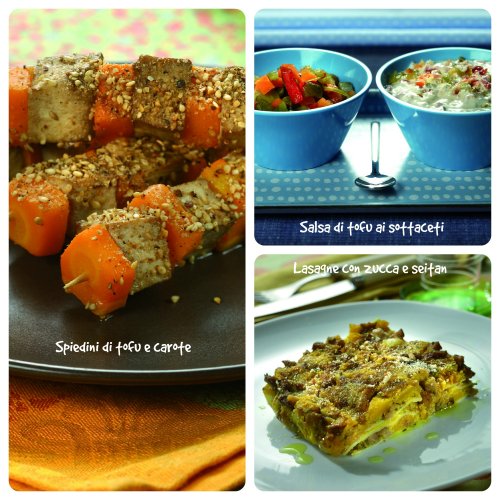
Tune in! We are going to broadcast the program "What a music in the kitchen," the duo Cristina Franzoni and Barbara Sambari, the score for tofu and seitan. Two voices, two songs and only two ingredients for a concert: the protein requirement.
Back by popular demand the cookbook Cooking tofu and seitan, with 100 tasty and healthy recipes to replace with no regrets products of animal origin. Everything in this book, is full of doubles: the second edition, the two authors, the double argument tofu and seitan, the dual use of these ingredients that you can do in the kitchen to completely replace animal proteins but also for integrate them, by now tradition and supported by traditionalistic nutritionists and dieticians
Tofu
Tofu and seitan , oriental- sounding names, so betray their origin in ancient China and Japan. For the production of tofu , obtained by curdling chopped and boiled soy , we must go back to monaco Taoist Lin An , a distinguished philosopher of more than 2000 years ago. The success then of this food introduced into the culinary culture of the Western macrobiotic , arrived undisturbed to our days thanks to two important features: ease of preparation and excellent nutritional properties .
Concernig soy in the book we can also find the descriptions of other dairy products : sauces and condiments such as miso, shoyu and tamari, which can enrich dishes of all kinds. Tamari, made of soybeans cooked and fermented with a certain yeast, is more dense and savory on the palate, unlike the shoyu made by mixing soybeans and wheat, flavored lighter. Miso, finally, is a mixture of rice or barley with the addition of soya left to ferment in wood for many months or even years. All these preparations are in some ways similar to our balsamic vinegar of Modena, whose strong taste and dense appearance owe to a long fermentation (up to 12 months) of cooked grape musts in special barrels. Stories able to pierce the centuries and cross the whole Earth.
Seitan
The birth of the seitan, the "steak of wheat", can still be traced back to the wisdom of the Chinese Buddhist monks, forced to look for a source of protein that was not animal meat: the two authors of „Cooking tofu and seitan“ have reported the use preparations made from gluten even in ancient recipes of Russian and Eastern Europe, and his arriving in the United States in the wake of numerous Mormons and Seventh-day Adventist community, whose religious beliefs still prohibits the consumption of animal products.
Seitan, which is also easy to prepare at home – one only needs flour, fresh water and a lot of patience - is based on a simple chemical-mechanical principle: remove the starch from the flour, which runs off with water, leaving to his place a thickened gluten. It is for this reason that the seitan represents a kind of wheat protein concentrate, where the percentage of protein varies from a minimum of 20% to a maximum of 36%, much higher than that of a beef steak or pork, but with a fat content of almost zero, between 0.3 and 0.7%.
It’s Your choice!
The recipe book of the couple Franzoni-Sambari also addresses the current panorama of their production, including biological and ogm farming and between industry and handicraft enterprises. A honest reflection that allows us to learn how to evaluate the product we are going to buy, unless we try to prepare it ourselves: even in this case the two provident authors advise us two walkthroughs in order to create a small home workshop .
In the final part of the book, then, the two cooks guide us into the heart of their kitchen: the recipes are divided by season, being tofu, more fresh and light, particularly suitable for spring and summer, and seitan, with a type of energy more slowly and heavily, to winter dishes.
Finally, one last double reason characterizesthe recipe book : on the one side it shows how with ease and immediacy as all the recipes that we are used to appoint referring to meat and dairy animal can be achieved with these two ingredients : tripe, veal chop, stew, kebabs, steak, paella, roast, rolls, cutlets, patties, carpaccio, fondue ; all names, instead of being signals to take a one-way street, indicate here a wealth of taste routes that are worth trying even only for curiosity 's palate. On the other hand, the other soul of the book is free of tradition and proposes creative recipes, from the refined tofu pancakes to the miso soup with seaweed and ginger, the lasagna with sauce of pumpkin and seitan, the cups of tofu, peaches in syrup. A concentration of haute cuisine, ingenuity and generosity.
Now it's up to us to choose, in our eternal dualism of modern men always divided between inner and outer, body and spirit, health and throat, how to feed our best part.
Download from our website 3 RECIPES drawn exclusively from the cookbook .





